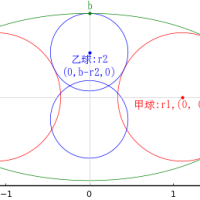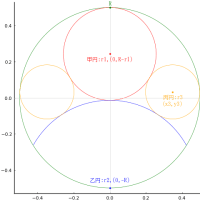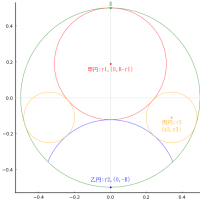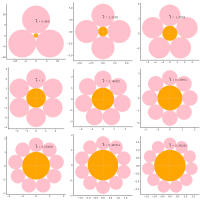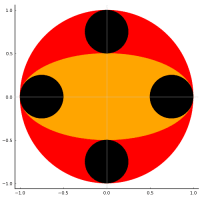R の e1071 ライブラリに bincombinations がある。
bincombinations(3) で,2^3 × 3 行列の結果が返される。
> bincombinations(3)
[,1] [,2] [,3]
[1,] 0 0 0
[2,] 0 0 1
[3,] 0 1 0
[4,] 0 1 1
[5,] 1 0 0
[6,] 1 0 1
[7,] 1 1 0
[8,] 1 1 1
要するに,n 桁の 2 進数の各桁が 2^n 行で表される。ただ,これだと結果が行列で返されるので,不都合な場合もある。また,一般に n 進数の結果が必要になることもある。bincombinations を一般化するのは,このページの下の方に再掲載しておく。
まず,与えられた n 進数表記の次の数の表記を与える関数を書いてみる。
next.Ncombination = function(x, base=2) {
n = length(x)
carry = 0
x[n] = x[n] + 1
for (i in n:1) {
x[i] = x[i] + carry
carry = 0
if (x[i] >= base) {
x[i] = 0
carry = 1
}
}
return(x)
}
この関数を
n = 4
base = 2
x = integer(n)
for (i in seq.int(base ^ n)) {
print(x)
x = next.Ncombination(x, base)
}
のように指定すると全ての組み合わせが得られる。bincombinations(4) と同じであるが,それぞれの結果はベクトルである。
[1] 0 0 0 0
[1] 0 0 0 1
[1] 0 0 1 0
[1] 0 0 1 1
[1] 0 1 0 0
[1] 0 1 0 1
[1] 0 1 1 0
[1] 0 1 1 1
[1] 1 0 0 0
[1] 1 0 0 1
[1] 1 0 1 0
[1] 1 0 1 1
[1] 1 1 0 0
[1] 1 1 0 1
[1] 1 1 1 0
[1] 1 1 1 1
上の使用例の print 文の位置に必要な処理プログラムを書けばよい。
tricombinations に相当するプログラムは base = 3 とするだけでよい。
> n = 4
> base = 3
> x = integer(n)
> for (i in seq.int(base ^ n)) {
+ print(x)
+ x = next.Ncombination(x, base)
+ }
[1] 0 0 0 0
[1] 0 0 0 1
[1] 0 0 0 2
[1] 0 0 1 0
[1] 0 0 1 1
[1] 0 0 1 2
[1] 0 0 2 0
[1] 0 0 2 1
[1] 0 0 2 2
中略
[1] 2 2 1 1
[1] 2 2 1 2
[1] 2 2 2 0
[1] 2 2 2 1
[1] 2 2 2 2
=================
オリジナルの bincombinations のソースプログラム
bincombinations = function (p) {
retval = matrix(0, nrow = 2^p, ncol = p)
for (n in 1:p) {
retval[, n] = rep(c(rep(0, (2^p/2^n)), rep(1, (2^p/2^n))),
length = 2^p)
}
retval
}
これを書き換えて,3, 4, 5, ... 進数に対応させた tricombinations, quatrcombinations, ... quintcombinations など
tricombinations = function(p) {
retval = matrix(0, nrow = 3^p, ncol = p)
for (n in 1:p) {
retval[, n] = rep(c(rep(0, (3^p/3^n)), rep(1, (3^p/3^n)), rep(2, (3^p/3^n))),
length = 3^p)
}
retval
}
quatrcombinations = function(p) {
retval = matrix(0, nrow = 4^p, ncol = p)
for (n in 1:p) {
retval[, n] = rep(c(rep(0, (4^p/4^n)), rep(1, (4^p/4^n)), rep(2, (4^p/4^n)), rep(3, (4^p/4^n))),
length = 4^p)
}
retval
}
quintcombinations = function(p) {
retval = matrix(0, nrow = 5^p, ncol = p)
for (n in 1:p) {
retval[, n] = rep(c(rep(0, (5^p/5^n)), rep(1, (5^p/5^n)), rep(2, (5^p/5^n)), rep(3, (5^p/5^n)), rep(4, (5^p/5^n))),
length = 5^p)
}
retval
}
sextetcombinations = function(p) {
retval = matrix(0, nrow = 6^p, ncol = p)
for (n in 1:p) {
retval[, n] = rep(c(rep(0, (6^p/6^n)), rep(1, (6^p/6^n)), rep(2, (6^p/6^n)), rep(3, (6^p/6^n)), rep(4, (6^p/6^n)), rep(5, (6^p/6^n))),
length = 6^p)
}
retval
}
septetcombinations = function(p) {
retval = matrix(0, nrow = 7^p, ncol = p)
for (n in 1:p) {
retval[, n] = rep(c(rep(0, (7^p/7^n)), rep(1, (7^p/7^n)), rep(2, (7^p/7^n)), rep(3, (7^p/7^n)), rep(4, (7^p/7^n)), rep(5, (7^p/7^n)), rep(6, (7^p/7^n))),
length = 7^p)
}
retval
}
あとは,ご自由に定義してください













